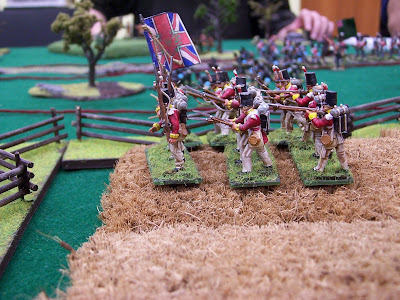[For those interested, Andy came up with the idea of a "mission" oriented game, in which each player had a 'mission' to fulfill, which might or might not bring them into conflict with the other players. I added the idea of encounters from Iron Ivan's pulp fiction game, "Where Heroes Dare." This is the third or fourth time we've runt his kind of game and it never fails to be fun! That is why we play, I suppose.]
Robby led his warband over the marsh, finding a mired field gun, the recovery of which would have been the mission of some US Regular artillerymen, if another player or two had joined. The braves hit the side of the US Rifles and almost wiped them out, stopping for an activation to scalp the casualties... gaining a Victory Point each. Andy marched his detail AND band and used the band to march off with a batch of cattle, sheep, and pigs. Neither he nor Robby aggrivated the skunk, although Rob killed it and threw it at the band. (Oddy enough, Rob, Beth, and I play in a local town band, Rob on baritone sax, Beth on auxiliary percussion, and myself on bass trombone.) Mark gathered up the cattle and turned them over to Andy. Then he proceeded to the beaver dam and destroyed it. Martin took a bit of time to find the boats but finally got them and brought them to the muster point. He found the still and had his superbly disciplined troops carry it along for his gin-soaked officers. Stephen encounted the rattlesnake nest and rifle-butted the snakes to death before they bit him. He was in the process of recoving the dispatch box from the brigands when the Natives bashed him. Four rifles escaped with the box. Steve's Regulars found the cache of hams, discovered the pay chest, escaped a forest fire AND the bear, and fought the Natives... getting the short end of the stick, but not before sending the hams and paychest off with a patrol led by his first sergeant. He also exchanged fire with Andy's redcoats. For me, the "new unit" curse was in full effect. I had just finished the batch of mounted rifles I was using as well as the engineer officer. They encountered and out distanced the refugee caravan, ran into the brigands who shot three, unhorsed three more, then charged and wiped all the rifles out. The engineer escaped and fulfilled his mission by finding the ford and high-tailing it back to base - with the bear in pursuit. I was the only one who did not fulfill his mission; I felt the loss of the entire escort force did not merit full Victory Points. Such is life. The Crown forces accumulated the most Victory Points, so they have bragging rights... until 5 minutes ago.
 |
| The crew around the table is the Crouch Library |
 |
| Stephen's rifles prepare to stomp the nest of snakes. The mounted rifles trot by in the background. |
 |
| Rob's Native warband deal with the skunk. I realize it looks like they're making friends with it, but they killed it and threw it at the band. |
 |
| Martin's nicely painted line infantry cross the cultivated field. {Live with the pain, Kevin!} |
 |
| Mark's Glengarries busily herd cattle. |
 |
| The BID officer, troopers, and tribal braves skirt the bee hives (on the right) |
The biggest issue of the day was communication. Andy, Mark, and Robby sent officers or sergeants to confer and swap mission descriptions. (No talking between players -besides the usual trash talk- without officers/NCOs 'talking' on the table.) The US side didn't. The players that cooperated made the biggest headway in fulfilling their missions. Important tip for the next time.
Since it was still early, a few of us set up a straight "shoot-em-up" game with three units of line infantry and a rifle-armed skirmish unit each. (Bear joined us for this one. He's a gamer, not the bear on the table.) Everything depended on who got the initiative, with the Crown forces did most often so the US lost.
 |
| US Regulars hold a ridgeline. |
 |
| Martin's nicely painted British line infantry advance. |
 |
| The British line. The "thing" behind the nearest office is the still, which Martin insisted on keeping from the adventure game. |
 |
| The US Regular infantry held it's ground... and paid for it. |
 |
| Like I said - paid for it in cash. (The yellow bingo chips denote "smoke" or loaded/unloaded status.) |
 |
| A view of the US infantry line. |
All in all, it was a fun day. The "Adventure" game takes some planning and some imagination as well as a sense of humour. I find the Iron Ivan rules for this period to be quite satisfactory and very flexible. They were written for the French and Indian War, but since the technology doesn't change until the advent of the percussion cap musket so it works well for 1812. It just takes some finagling for the troop types, mainly just assigning values to the different types - Regulars, Volunteers, Fencibles, Militia, Native warbands, and the very rare elites. Brown Bess had a long and distinguished career. (Some were used in the American Civil War and rumour has it some were issued to some units of Ireland's Home Defense Volunteers in the 1940's when invasion threatened. Now THAT would be an interesting twist to a Disposable Heroes game!)
























